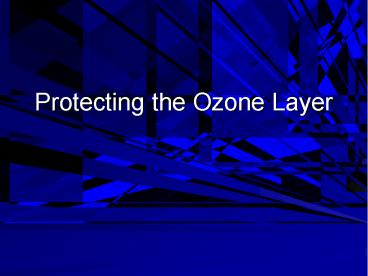Protecting the Ozone Layer - PowerPoint PPT Presentation
Title:
Protecting the Ozone Layer
Description:
Protecting the Ozone Layer Stratospheric Ozone Depletion Ground-level (tropospheric) ozone: harmful pollutant Stratospheric ozone: shields the Earth surface from UV rays. – PowerPoint PPT presentation
Number of Views:642
Avg rating:3.0/5.0
Title: Protecting the Ozone Layer
1
Protecting the Ozone Layer
2
Stratospheric Ozone Depletion
- Ground-level (tropospheric) ozone harmful
pollutant - Stratospheric ozone shields the Earth surface
from UV rays.
3
Stratospheric Ozone Depletion
- F. Sherwood Rowland and Mario J Molina (1974)
- CFCs break down in the upper atmosphere
- Release chlorine
- Chlorine reacts with ozone,
- Ozone layer depletion
- Paul Crutzen (1970)
- Nitrogen oxides may deplete the ozone layer
- More UV radiation
- skin cancer, cataracts, damage to other
organisms, materials, crops
4
Global Commons Problem
- Non-excludable free access
- Subtractable more CFCs less ozone layer
- Private costs of limiting CFC production and
consumption exceed private benefits reducing
ozone depletion - No central governing authority
- Scientific uncertainty
- International cooperation required
5
- But No Tragedy of the Commons?
- Why?
6
- Drama of the Commons
- The Ozone Layer Regime
7
Act I Unilateral Action
- U.S. Regulations
- In 1978 US unilaterally banned the use of CFC
propellants in spray cans - Canada, Norway, Sweden
- Also restricted the use of CFC aerosols
8
Act IIDeadlock
- 1977-1985 complete deadlock , some symbolic
actions - Opponents to further regulation in US
- EC not interested to limit use in aerosols,
suspects US of using science to advance
commercial interests.
9
Act IIIThe Breakthrough
- The Vienna Convention on the Protection of the
Ozone Layer (1985) - -Encouraged research, cooperation among countries
and exchange of information. - -For the first time nations agreed in principle
to tackle a global environmental problem before
its effects were felt, or even scientifically
proven. - The Montreal Protocol (1987)
- Production and consumption of 5 CFCs to 50 of
1986 levels by June 30 1998. Freeze 3 Halons.
10
Act IVBroaden Participation
- The 1990 London amendments
- Complete ban on 15 CFCs, 3 halons, carbon
tetrachloride by 2000, and methyl chloroform by
2005 - Multilateral Fund
- funds the incremental costs incurred by
developing countrie in ODS phasing out - 240 million initial endowment fund to be spent
over three years - By 2001, 1.2bn contributed to the fund 3500
projects in 124 countries. - No ODS trade with countries, which are not
parties to the treaty - Developing countries 10 year grace period for
compliance. - China, India and Brazil joined
11
Act IVTight International Regulations
- Amendments adopted at Copenhagen (1992), Vienna
(1995), Montreal (1997) and Beijing (1999). - Ninety-six (96) chemicals are presently
controlled by the Montreal Protocol, including - Chlorofluorocarbons (CFCs) and Halons.
- Carbon tetrachloride
- Methyl chloroform
- Hydrochlorofluorocarbons
- Methyl bromide
12
Act VTragedy of the Commons Averted?
13
Effect of Ozone Regime?
- 1988 ozone hole
- 2000 ozone hole
14
Tragedy of the Commons Reversed
15
Caveats
- Imperfect compliance in Eastern Europe
- Illegal trade in CFCs
- Supply production still legal in some parts of
the world imperfect compliance by some former
communist countries - Demand older equipment (car AC, etc.).
16
Discussion
- What explains the success of the
- Montreal Protocol?
17
The Role of Science
- Placed the issue on policy agenda
- Consensual science necessary for cooperation
- WMO/NASA Assessment (1986)-authoritative, peer
reviewed assessment on stratospheric ozone large
losses if CFCs grow by about 3 - Ozone Trends Panel (1988) ozone hole CFCs the
main culprits - Depends on participation, sponsorship,
procedures, outputs
18
Implications
- Institutions should allow adaptation of rules
- -Even weak treaties can ratchet up
- Early targets important for innovation
irrespective of stringency - Feedback b/w regulation, technology, innovation,
and domestic politics - Repeated negotiations help ratcheting up
- Authoritative, consensual science essential
- Institutions can alter the cost and benefit
structure of cooperation































